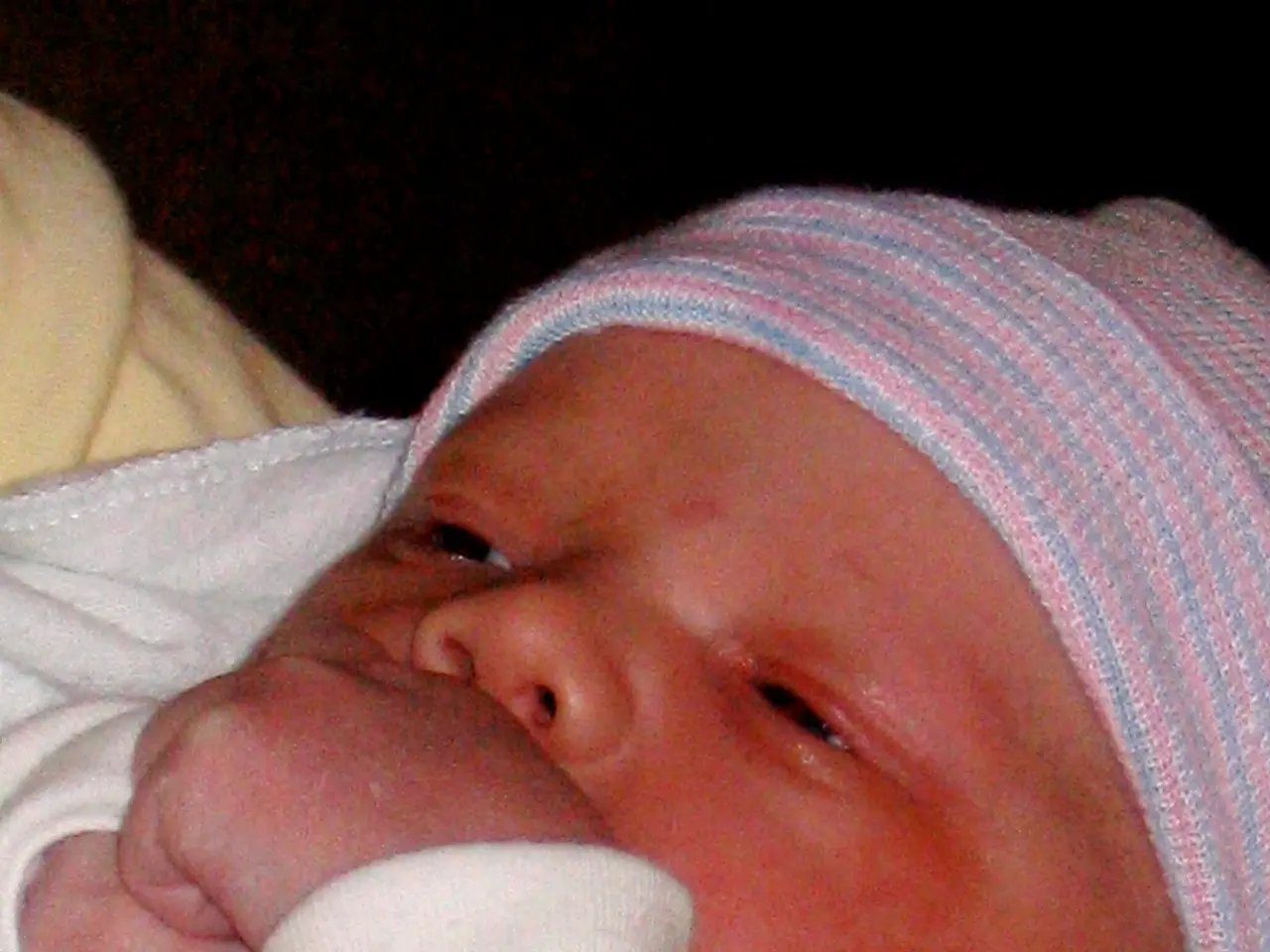Identifying Indications of Infant Brain Hemorrhage: A Handbook for Parents
News Article: Understanding the Long-term Effects and Survival Rates of Brain Bleeds in Babies
Brain bleeds, also known as intracranial hemorrhages, can pose significant risks for newborn babies, particularly those born prematurely. These events can lead to a host of short-term complications, such as seizures, decreased reflexes, and developmental delays.
In the long term, the effects and survival rates of brain bleeds in babies vary greatly depending on factors like the type, location, and severity of the bleed, as well as the timeliness of treatment received.
One common long-term effect is Periventricular leukomalacia (PVL), a type of white matter brain injury often seen in premature infants with brain bleeds. PVL can lead to serious problems with movement, coordination, muscle control, and developmental delays. In severe cases, it may result in cerebral palsy, particularly the spastic diplegia form that affects leg movement and causes muscle stiffness.
Untreated or severe brain bleeds can also cause brain damage, neonatal encephalopathy, seizures, hypoxic-ischemic encephalopathy (HIE), cerebral palsy, and developmental disabilities, including autism spectrum disorders. These effects typically arise from blood loss leading to oxygen deprivation of the brain.
Infants who survive brain hemorrhage may face developmental delays, spasticity (muscle stiffness), speech delay, and other cognitive deficits related to white matter injury or ischemia.
When it comes to survival rates, certain types of severe brain hemorrhages, like subgaleal hematomas, carry a mortality rate of approximately 10-25%. However, with prompt treatment (transfusions, surgery if needed), many infants can recover.
More premature births and complications like bronchopulmonary dysplasia increase the risk for poorer neurodevelopmental outcomes and survival challenges after brain bleeds. Research has shown that specialized hemodynamic care can reduce the risk of death or severe brain bleeding by half, indicating improved survival chances with modern NICU care.
In summary, early diagnosis and prompt medical treatment are critical to improving survival and limiting long-term brain damage in babies with brain bleeds. The extent of brain injury dictates the severity of disabilities and developmental outcomes.
If you are concerned about a specific case, consulting with a neonatal neurologist or specialist familiar with neonatal brain hemorrhage is essential for prognosis and management options. It is important to note that babies weighing less than 3 pounds, 5 ounces at birth are more likely to experience a brain bleed, and certain medical conditions, such as hemophilia and thrombocytopenia, can elevate the risk. Additionally, breech delivery and assisted delivery with forceps or ventouse (suction) increase the risk of a brain bleed.
Babies with a brain bleed may exhibit a range of symptoms, including apnea, bradycardia, cyanosis, bulging at the fontanel, seizures, weak suck and poor feeding, irritability, and abnormal eye movement. If you suspect your baby may have suffered a brain bleed, it is crucial to seek immediate medical attention.
[1] Periventricular leukomalacia. (2021, February 12). Retrieved August 22, 2022, from https://www.ncbi.nlm.nih.gov/books/NBK548357/
[2] Neonatal intracranial hemorrhage. (2021, March 23). Retrieved August 22, 2022, from https://www.ncbi.nlm.nih.gov/books/NBK548358/
[3] Neonatal intracranial hemorrhage. (2021, March 23). Retrieved August 22, 2022, from https://www.ncbi.nlm.nih.gov/books/NBK548358/
[4] Neonatal intracranial hemorrhage. (2021, March 23). Retrieved August 22, 2022, from https://www.ncbi.nlm.nih.gov/books/NBK548358/
- The survival rates and long-term effects of brain bleeds in babies also impact their brain function, which is crucial for future well-being and development, particularly in areas like learning and memory.
- Science continues to explore the relationship between brain bleeds in infancy and the risk of chronic diseases later in life, such as cardiovascular health issues and cancer.
- Workplace wellness programs can include education about the importance of proper sleep for brain function and overall health, which is particularly critical for those who had brain bleeds as infants.
- Respiratory conditions, such as asthma and bronchopulmonary dysplasia, can make it more challenging for infants with brain bleeds to recover, emphasizing the role of health and wellness in a holistic patient care approach.
- Skin care becomes essential for infants with brain bleeds who spend extended periods in the Neonatal Intensive Care Unit (NICU), especially those with skin conditions caused by clothing or medical tape adhesives.
- Hearing loss can occur in children with brain bleeds, necessitating regular audiology evaluations to detect issues and establish appropriate therapies and treatments.
- Autoimmune disorders, such as lupus and multiple sclerosis, often manifest in adulthood, and their management requires a thorough understanding of the patient's medical history, including a possible brain bleed as a baby.
- Mental health issues, such as anxiety and depression, are common in adults who had brain bleeds as infants, highlighting the need for ongoing support and treatment in the realm of mental health care.
- Fitness and exercise can play a significant role in maintaining good physical health and promoting overall well-being for individuals with a history of brain bleeds, particularly those related to chronic diseases like diabetes and high blood pressure.
- Medicare and other insurance providers should recognize the lifelong implications of brain bleeds in babies, ensuring that patients have access to specialized treatments and therapies for neurological disorders, eye-health concerns, hearing issues, and skin-conditions.
- Sports involvement, whether professional or recreational, requires the athlete to be aware of any pre-existing conditions, such as brain bleeds, that could increase the risk of additional neurological injuries, necessitating appropriate preventive measures, therapies, and treatments.




